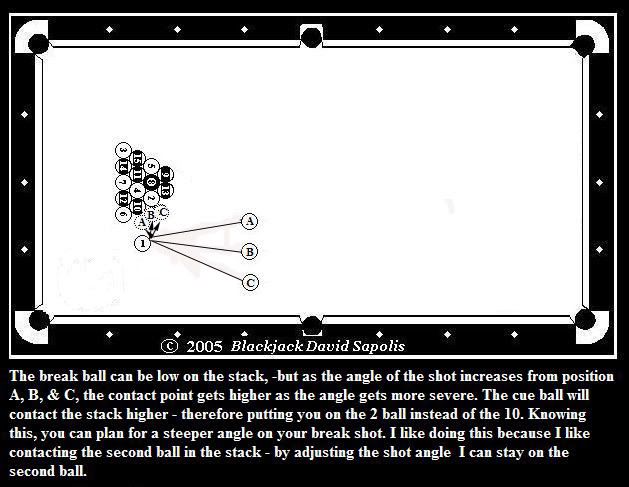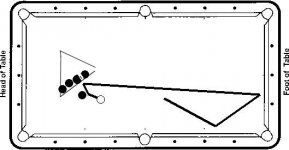Regarding side of the rack breaks:
You see a lot of them in videos going up and figuring out where the tangent line is going to hit. Based on this, many of them know what they want to do.
Are they trying to alter where on the rack they will hit, by using high or low to get a desired result?? /QUOTE]
Depends on the angle and distance. Note that thin angles suggest higher cueball speeds into the rack, thicker demands more whack to free the cue ball. This is art not science. Thicker angles of the 10 to 15 degree variety offer greater cueball control, but less power. Balance.
As Bob Jewett and Bob Byrne or David Alciatore or other like-minded folks have pointed out, when you are hitting at a half-ball angle smaller variation is likely which is useful in all games and carom games especially. Accurately judging this key shot is a game-changer.
But you simply MUST MAKE the break ball, or all is in vain, you can't win from the bottom of the pocket scratching or missing the shot.
dmgwalsh said:
Are they using high, low, right or left to affect the way the cue ball reacts once it hits wherever the tangent line is sending the cue ball?
Is it a combination of both of these ideas? (Sometimes because of a thin hit or proximity to the rack, it would be hard to change where on the rack the cue ball hits)
It must be the balancing act between both of those ideas. If you can't realistically change the angle of attack into the balls, you have two choices, burrow into the balls with a thin hit and speed and follow and hope to spring free on the other side like Mizerak, or, draw away and to the side with maybe or not a touch of spin perhaps off a rail towards center to maximize next shot choices on the other side of the rack. What can YOU do/envision as likely?
The key thing is your personal judgment of what is likely to happen if you do X and your expected next choices likely Y can never be removed from the game, these factors are based on your skill level and ability to make good on those expectations, and result in the art that good pool is made from. Yo baby, it is your stroke and possibilities you can do see and realistically make happen. Not everybody can do what you are sure you can do, and some can consistently do more than you can do.
Your brain automatically deduces the likely future layout if you let it. Don't fight nature, work with it. The perfect shot percolates upward and is known inside you already, let it out, if you believe it will work and the time is ripe.
dmgwalsh said:
Can we come up with some general concepts as to what to do if the cue ball hits (a) center of ball, (b) top of ball, (c) crotch between balls, (d) bottom of ball? Might it vary depending upon which of the balls is being contacted, i.e. high or low or middle of rack??
Absolutely, we can and we should, in general. But there are three variables cited and a fourth, specifically what angle the cue ball is heading into the rack.
There are big effects and small effects, but I suggest the fourth input, the angle the cueball is heading into the rack with either follow or draw, is of greatest importance.
If cueball hits the second from last ball on the lower end and is angled towards the center foot diamond, with anything less than trick-shot force follow speed, it cannot scratch in the near foot pocket, nor scratch in the forward pocket, there are too many balls in the way. It is a safe break and can be hit with confidence and rack-spreading speed.
If the cue is center table, glancing 30 degrees off the side of the rack with speed towards the foot of the table, bad scratches can be foreseen. Bounce hard from the high side, follow forward and hook to the foot, scratch. Natural.
Thin hits excessive speed or spin from the top of the rack often result in !unforeseen! scratches bottom, side, or 3 or 4 railer scratches as well. I joke on unforeseen, letting whitey loose is asking for disaster.

